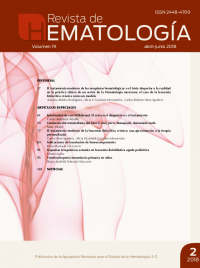Enfermedad de von Willebrand. El reto en el diagnóstico y el tratamiento*
Von Willebrand disease. The challenge in the diagnosis and treatment.
Rev Hematol Mex. 2018 abril-junio;19(2):61-72.
Carlos Martínez-Murillo
* Presentado en el LIX Congreso Nacional de Hematología, 25-29 de abril de 2018. Nuevo Vallarta, México.
Servicio de Hematología, Hospital General de México, Ciudad de México, México.
Resumen
La enfermedad de von Willebrand es un trastorno hemorrágico hereditario caracterizado por un defecto cuantitativo o cualitativo del factor de von Willebrand (FvW). Afecta 0.1-1.3% de la población general; sin embargo, muchos sujetos son asintomáticos a pesar de tener bajas concentraciones del factor de von Willebrand. Los sujetos sintomáticos representan 1 por cada 10,000 nacidos vivos (0.01% de la población). El 5 a 20% de las mujeres son diagnosticadas por antecedente de menorragia. La enfermedad se distingue por hemorragias mucocutáneas de intensidad variable que tiende a ser fluctuante; son más intensas en niños y adolescentes. La determinación del factor de von Willebrand: antigénico (FvW:Ag) y el cofactor de ristocetina (FvW:RiCo) son las pruebas básicas para establecer el diagnóstico de enfermedad de von Willebrand, estudios adicionales, como la agregación plaquetaria inducida por ristocetina (RIPA) y el estudio de los multímeros, permiten caracterizar a la enfermedad de von Willebrand para un tratamiento apropiado. El tratamiento usualmente es para corregir la hemorragia o prevenirla en caso de un procedimiento quirúrgico. La elección del tratamiento depende del subtipo de la enfermedad de von Willebrand y la naturaleza de la diátesis hemorrágica, los de elección son la desmopresina y la terapia transfusional con productos sanguíneos. Entre los tratamientos coadyuvantes están los inhibidores de la fibrinólisis, las preparaciones de estrógenos-progestágenos orales y las fibrinas adhesivas.
PALABRAS CLAVE: Enfermedad de von Willebrand; factor de von Willebrand; desmopresina.
Abstract
Von Willebrand disease (VWD) is a hereditary bleeding disorder characterized by a quantitative or qualitative defect of von Willebrand factor (VWF). It presents from 0.1 to 1.3% of the general population; however, many subjects are asymptomatic despite having low concentrations of von Willebrand factor. Symptomatic subjects are presented in 1 per 10,000 live births (0.01% of the population). Women from 5 to 20% are diagnosed by history of menorrhagia. The disease is characterized by mucocutaneous hemorrhages of variable intensity and tends to be fluctuating, being more intense in children and adolescents. The determination of the von Willebrand factor: Antigenic (FvW: Ag) and the cofactor of ristocetin (FvW: RiCo) are the basic tests for Von Willebrand disease, additional studies such as platelet aggregation induced by ristocetin (RIPA) and the study of multimers allow to characterize the VWD for an appropriate treatment. The treatment is usually to correct the presence of hemorrhage or prevent it in the case of a surgical procedure. The choice of treatment depends on the subtype of the Von Willebrand disease and the nature of the hemorrhagic diathesis; the ones of choice are desmopressin (DDAVP) and transfusion therapy with blood products. Among the adjuvant treatments are fibrinolysis inhibitors, oral estrogen-progestagens preparations and adhesive fibrins.
KEYWORDS: Von Willebrand disease; Von Willebrand factor; Desmopressin.

